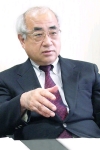What can the ILC do to get students back to science?
A conversation with economics professor and author Kazuo Nishimura

Kazuo Nishimura |
“Less than 50 percent.” This is the shocking data that Kazuo Nishimura, the head of the Economic Research Institute at Kyoto University, one of the well-respected educational institutes in Japan, reported in his book University students who cannot calculate fraction numbers. Nishimura believes that the ILC could be one of the remedies to fix the world-wide epidemic of students moving away from science. ILC NewsLine recently had the opportunity to discuss this growing trend with the economics professor.
Read more...
-- Nobuko Kobayashi and Rika Takahashi |
|
 |
Annual ILC software workshop reviews whole chain of data analysis

Group photo of the ILC Software Workshop, in front of LAL entrance |
Even the best detector will be useless without clever reconstruction algorithms and software. On 2-4 May 2007, the ILC Software Workshop was held at LAL, Orsay (France). The whole chain of data processing was reviewed there: software framework and tools, algorithms and physics results. At the end of the workshop, DESY physicist Ties Behnke summarised that significant progress has been achieved over the past year and important performance milestones are close to being reached, even though the community is still small. Cambridge physicist Mark Thomson, finished his contribution declaring he was now convinced that Particle Flow Algorithm (PFA) can meet the ILC performance goals at 500 GeV and 1 TeV.
Read more...
Workshop links : Website - Talks - Photos
-- Perrine Royole-Degieux |
 |
|
|
 |
From SLAC Today
8 May 2007
SLAC and CERN Collaborate in Testing a New Accelerator
Parts of the Compact Linear Collider (CLIC)-CERN's experimental project to accelerate electrons in a unique and powerful way-are currently being tested at SLAC.
Read more... |
|
From SLAC Today
7 May 2007
Stopping Stray Electrons in Their Tracks
...Collimators are pieces of metal fitted inside a beam pipe, allowing the focused core of the beam through while blocking stray electrons (or positrons). The job of the International Linear Collider (ILC) group is to develop and test collimators that effectively deal with the nonconformists without disrupting the rest of the beam.
Read more... |
|
From FYI: AIP Bulletin of Science Policy News
4 May 2007
Broad Support for FY 2008 DOE Science Request
The American Institute of Physics, American Physical Society, Optical Society of America, and 54 other corporations, associations, and academic institutions have endorsed a statement supporting the Administration's FY 2008 request for the DOE Office of Science. Under this request, funding would increase from the current budget of $3.8 billion to $4.4 billion.
Read more... |
|
From symmetry magazine
April 2007
A Quest for Balance in Canada
Canadian subatomic physics has a lot going for it: sparkling new hardware,
an influx of bright young minds, and key roles in international projects.
But only by doubling its operating budget can it live up to that potential,
a new report suggests.
Read more... |
|
From symmetry magazine
April 2007
Commentary: Nigel Lockyer
TRIUMF in Canada
Canada, affectionately known to Americans as the “Great White North,”
boasts the world's largest reserve of fresh water and the biggest oil
reserves outside the Middle East. It's the largest trading partner of the
United States; and when it comes to science, it's destined to become the
main regional partner of the United States, as well.
Read more... |
|
|
 |
 |
|
|
 |
DOE and NSF Review of the
ILC-Americas Programme

Hasan Padamsee presented the latest ILC Americas cavity results, including a report on a reentrant shape cavity that is now at Cornell University. |
The second review of the US R&D programme for the International Linear Collider (ILC) by the Department of Energy (DOE) and the National Science Foundation (NSF) was held at Fermilab from 30 April to 2 May 2007. This meeting served as DOE and NSF's primary peer review of the US portion of ILC R&D activities. The goal of the review was to evaluate the achievements and future planning of the US ILC programme, and those activities needed to position the US as a possible host. Items addressed included Americas Regional Team (ART) organisation and management of the programme, the FY2006 R&D programme accomplishments, the R&D plan, milestones and resource needs for FY2007 and beyond, and plans for US activities relating to development of test infrastructure and industrial partnerships.
Read more...
-- Gerry Dugan
Director's Corner Archive |
 |
|
|
 |
|
What is it?

Can you identify what is featured in the above image? Write ILC NewsLine
and take your best guess! We will
feature the first right answer we receive in next week's issue.
|
 |
|
|
 |
Announcing ALCPG07
ALCPG07
is the next in a continuing series of North American regional
meetings on the physics, detector and accelerator issues of the future
International Linear Collider and will be held at Fermilab on 22-26 October.
Key objectives for this meeting will include presentation and discussion on
progress toward the ILC Engineering
Design Report (EDR), as well as physics studies, detector R&D and integrated
detector design efforts. In parallel with the ALCPG07 meeting, the World
Wide Study (WWS) will review the status of vertex detector R&D of the
detector concepts. (This conference is pending DOE approval.)
More information and a web site will be available soon.
arXiv preprints
705.1089
8 May 2007
Probing Higgs-sector CP Violation at a Photon Collider
705.0554
4 May 2007
Fermionic Effective Operators and Higgs Production at a Linear Collider
705.0431
3 May 2007
Phenomenology of the nMSSM from colliders to cosmology
EUDET Report
2007-02
Detectors for a Linear Collider
ILC Notes
2007-017
Proposal to modify the polarimeter chicane in the ILC 14 mrad extraction line
2007-013
Start-to-end beam optics development and multi-particle tracking for the ILC undulator-based positron source
2007-012
Depolarization Studies in the International Linear Collider
|
|

